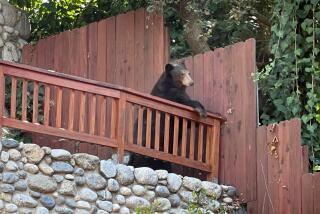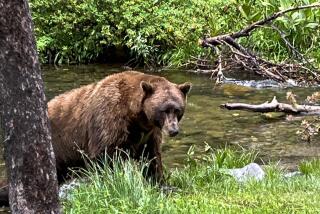Protecting the Kings of the Wild Frontier : Alaska’s Great Kodiak Bear Turns Out to Be a Beauty of a Beast
- Share via
KODIAK, Alaska — Kodiak Island’s big brown bears, kings of an island refuge set aside especially for them, are living proof that civilization still tolerates some things it cannot tame.
The bears, coastal cousins of interior Alaska’s grizzlies, are the largest land-dwelling carnivores on Earth. And, in a world where wildlife is shrinking, they are bucking the trend. Kodiak bears are thriving.
Scientists call them Ursus arctos middendorfi, a population isolated since a glacier carved this island off the south-central Alaska mainland 10,000 years ago. Hunters call them trophies and make pilgrimages to test themselves against the animal known as North America’s most dangerous game.
But wildlife managers on Kodiak know the bears as reclusive, independent creatures that don’t quite live up to their fierce reputation.
Their challenge is to keep the bear population healthy while accommodating more and more human visitors to the 1.8-million-acre Kodiak National Wildlife Refuge. The number of visitors is expected to double by 1995, and refuge managers hope to handle the crush better than it has been handled elsewhere.
“Historically, our success in managing bear populations hasn’t been good,” said Vic Barnes, a U.S. Fish and Wildlife Service biologist on Kodiak.
Grizzlies once roamed the western mountain states, but early settlers killed them off. In Yellowstone National Park, long a grizzly stronghold, an estimated 200 bears remain and the debate centers on whether to call them endangered or threatened.
Fifty years ago, Kodiak’s bears were heading down the same trail. Ranchers had introduced cattle to the island, and the bears found them delicious. The ranchers complained and the government sent in professional bear hunters.
But conservation and sportsmen’s groups in the Lower 48 states sided with the bears. Here was a place, they said, where civilization could swallow its impulse to destroy the big, bad beasts and choose instead to preserve them as symbols of unspoiled wilderness.
Their arguments were heard in Washington, and in 1941 President Franklin D. Roosevelt declared the southern two-thirds of the huge island a national wildlife refuge.
Bear-lovers and ranchers have skirmished since then and concessions have been made on both sides. But luckily for the bears--and partly because of them--ranching on Kodiak Island has proved marginally profitable. The number of ranches has declined in recent years.
By contrast, the bear population has remained stable or even increased, biologists estimate. The refuge now harbors 2,000 to 2,500 animals, a concentration of brown bears surpassed nowhere else, Barnes said. About 500 more live outside the refuge on Kodiak and nearby islands.
Among the bears’ biggest champions are the people who love to kill them. Kodiak Island has long been a magnet for big game hunters. The three largest Alaska brown bears ever taken by hunters lived on Kodiak, according to the Boone and Crockett big game record book.
Hunting is still allowed, and about 130 bears are shot each year, said Roger Smith, a biologist with the Alaska Department of Fish and Game. Many are killed by hunters from outside Alaska under the direction of one of 15 licensed bear guides on Kodiak.
One of the 15 is Leon Francisco, who has guided nearly 300 hunters from all over the world in 22 years on the island. These days he takes out a dozen hunters a year, charging $7,500 for a 10-day trip and promising an 80% to 100% chance of a successful hunt.
Francisco is a muscular, serious man of 48 whose quiet manner cannot hide his firm opinions about the bears he hunts for a living.
The demonic Kodiak bears of myth and legend are just that--myths and legends perpetuated by people whose only impressions of bears come from movies, books and sensationalized news stories of rogue bears and mangled hikers, he said.
“We have bears around all summer,” said Francisco, who fishes at his wilderness camp between the spring and fall hunting seasons. “They’re in the yard, in the skiffs, in the nets. They never cause much trouble.”
He does not deny the power of Kodiak bears, which can weigh more than half a ton and stand more than 10 feet tall. Using six-inch claws and massive forelegs, they can tear through a cabin wall or crush a 55-gallon drum like a sardine can.
But they aren’t bullies, said Francisco. When they aren’t sleeping the winter away in mountain dens, the bears are busy growing fat on Kodiak’s abundant spawning salmon or foraging for roots, berries and grasses.
“They live in lush surroundings,” he said. “They just go about their business.”
A score card may help judge whether man or beast is more aggressive. Since 1961, 3,300 brown bears have been shot by hunters on Kodiak Island. Refuge records show that in the last 10 years, bears have attacked five people. None of the attacks resulted in death or disabling injuries.
Bears learned long ago not to loiter near the city of Kodiak, a fishing port of 6,000 on the island’s northeast corner. And residents of the half a dozen small villages around the island’s coast have few qualms about eliminating bears that come too close too often.
The bears survive elsewhere on the island because it is wild. There are almost no roads within the refuge and 4,000-foot mountains that rise sharply from the sea discourage human settlement.
To ensure that the bear’s wild home remains so, the Fish and Wildlife Service is drafting a refuge management plan that calls for 73% of the refuge to be designated formally as wilderness. Hunting still would be allowed, but off-road vehicles would be barred and new commercial activities, such as oil and gas development, would be curtailed.
Some local fishermen and hunting guides fear that the wilderness designations will limit their use of the refuge, while conservation groups such as the Wilderness Society and National Audubon Society urge wilderness designation for the entire refuge. Congress will decide how much wilderness is designated.
In the end, the wilderness label may be more important to people than it is to bears, said Smith, who for four years has studied how the bears react to a sudden intrusion of civilization into their territory.
In 1982, construction began on the Terror Lake hydroelectric project on the island’s northern end. A construction camp of 500 workers descended on the wilderness. Heavy equipment rumbled through the forest and helicopters buzzed overhead.
Did the bears head for the hills? Not really, Smith discovered, as he monitored dozens of bears fitted with radio collars.
One female moved away, then returned to her old haunts in 1984 after construction stopped. But others were oblivious to human activity and some bears hung around even more, attracted to garbage generated by the camp.
“They’re definitely pretty tolerant of people,” Smith said. “But people aren’t real tolerant of them.”
The tolerance level appears to shrink as the number of people grows. Refuge planners predict at least 14,200 visitors a year by 1995, up from the current 7,400. Most of the increase is expected in the form of deer hunters, whose fresh kills and gut piles often act as bear bait.
Already the run-ins have increased between hungry bears and hunters. Alaska law allows someone to shoot a bear without a permit in a life-threatening situation, and such kills on the refuge have increased, from about two per year in the 1970s to an average of four a year. In 1984, 12 bears were killed.
To avoid more such kills, managers will concentrate on teaching visitors how to avoid attracting bears by keeping clean camps and how to distinguish an angry bear from one that’s just curious. Eventually, there may be more restrictions on back-country use and camping sites, or lower quotas for the annual bear hunts.
But the best answer, managers say, may be encouraging the right attitude, reminding people that the Kodiak refuge is a place where bears belong and humans are visitors.
“If you ever got people educated enough to where they wouldn’t attract bears, you wouldn’t have the problems,” Smith said. “But I don’t think we’re going to come up with a recipe for making bears and people totally compatible.”
More to Read
Sign up for Essential California
The most important California stories and recommendations in your inbox every morning.
You may occasionally receive promotional content from the Los Angeles Times.













